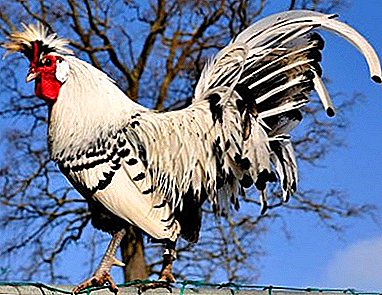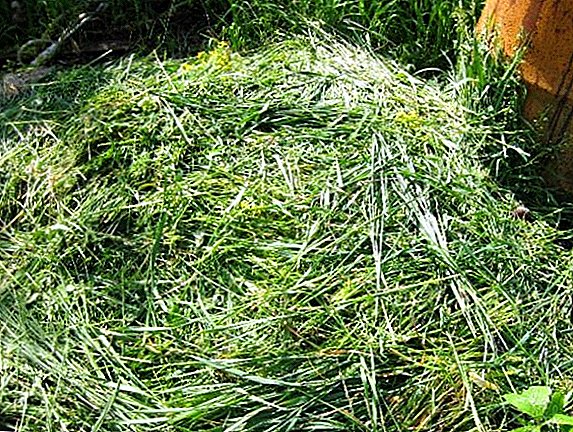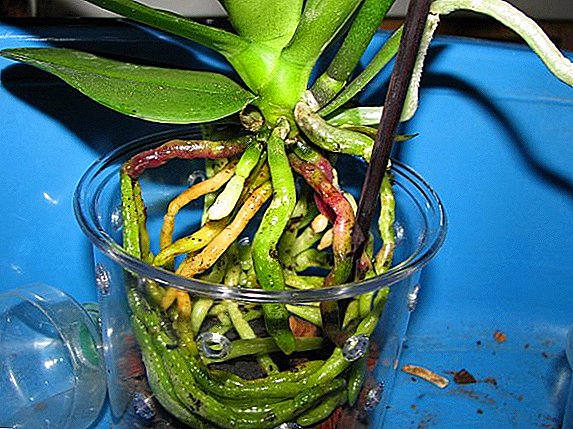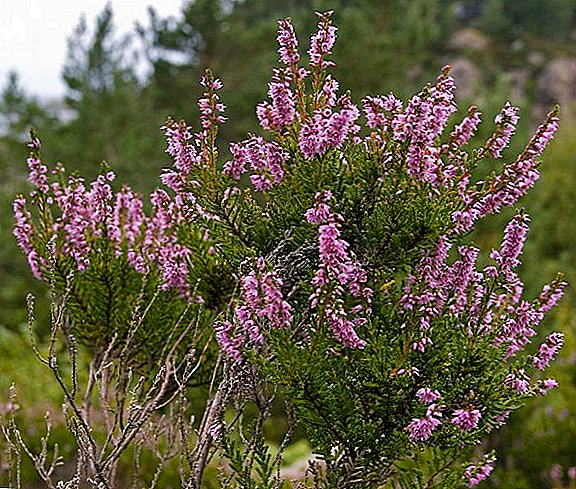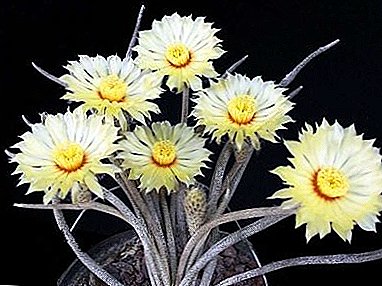
For many years, cacti remain popular among amateur flower growers.
They attract attention with an exotic decorative look, not a complicated care, charming (albeit rare) flowering.
Among the various representatives of these exotics, Astrophytum is in special demand.
Description and origin
Homeland cactus - arid arid territories of Africa and Mexico. The flower first appeared in Europe in the 18th century, thanks to the Belgian researcher Henri-Guillaume Galeotti. In 1839, Charles Lamer introduced the name "Astrophytum" as a whole separate genus.
Currently, these cacti are often grown as an indoor plant. They are distinguished by unpretentious care, slow growth, attractive exotic appearance. They are characterized by a spherical shape with vertical grooves. Some species have spines, most are missing. Blossom "Astrophytum" in the spring and summer.
Types of cactus "Astrophytum" with photos
In the main classification, there are only 6 species of this plant. In culture, four of them are more common.
"Capricorn" (Capricorne)
A species growing in the desert regions of Mexico. Sun-loving plant. The stem of the young "Astrophytum" has a spherical shape, and then lengthens and becomes cylindrical. At home, growing slowly. At the same time the adult plant can reach 25 cm in length.
Endowed with sharp, high, straight ribs. Color is dark green. From above, the cactus is covered with yellowish flakes, especially near the crown. Spines long (up to 8 cm), interlaced, flattened shape, dark brown color. Blooms large (up to 8-10 cm) flowers of yellow color.
The photo shows "Astrophytum Capricorn":
"Star" (Asterias)
Perhaps one of the most interesting species. In room conditions reaches 15-20 cm in diameter. The plant is a spherical shape with a slightly flattened crown. Stem with 6-8 weakly pronounced ribs. Without prickles. The flowers are beautiful, large (8 cm), yellow in color with a red heart.
The photo shows Star Astrophytum:
Mottled (Myriostigma)
Most often found in culture. It is a spherical plant endowed with a gray-green stem with five sharp edges, on which are pubescent areoles without thorns. Flowers are yellow with red-orange hearts, large. The people of this type is often called the "episcopal miter." Speckled "Astrophytum" can be with white specks or without them. There are representatives with 3,4,6 ribs.
The photo shows "Astrophytum Spotted":
"Decorated" (Ornatum)
The young plant has a spherical stem, which, as it grows, begins to be pulled into the column. Height of an adult plant is about 30-40 cm. In a natural environment it can grow up to one meter in length. The stem is dark green, divided into 6-8 slightly curved ribs, covered with silvery specks on top.
On the areola are 6-11 thin spines yellowish, hard to the touch, 3-4 cm in length. The plant begins to bloom only after 24-25 years. Flowers are large, light yellow, 6-9 cm in diameter.
The photo shows "Astrophytum Decorated":
Home care
To care for the plant is not difficult. Stick to the basic rules and you will not have problems with growing "Astrophytum".
Actions after purchase
Please note that immediately after the purchase you need to do the transfer of the cactus. The container and the substrate in which the plants are located in the store are not suitable for permanent cultivation. They are used only for temporary overexposure of plants before they are sold.
Lighting
 The flower likes good lighting.
The flower likes good lighting.
It will be very comfortable for him to be on the bright window sills of the windows facing the south or south-east.
"Astrofituma" well tolerate a long stay in the open sun.
But, on hot days, it is recommended to take care of shading from the sun to protect the flower from burns.
In warm weather, often ventilate the room, take the plant to fresh air to breathe.
In late autumn and winter, it is recommended to take care of additional artificial light.
Temperature
In spring and summer the temperature in the room should be 23-28 degrees. With the advent of cold, it gradually decreases. In winter, there comes a time of rest. It is very important that the flower is in a cool room with a temperature of 12-16 degrees. The most comfortable plant will be on a cool window-sill near the window.
Watering and humidity
"Astrophytum" tolerates dry air, does not need additional moistening or spraying with water.
In the warm season, you need regular watering - 1.2 times a week. In the fall it is gradually reduced. In winter, it should be watered only as needed.
Fertilizers
In its natural habitat, cactus grows in desert areas, where the soil is depleted in minerals. When growing at home, it grows well without supplements. If you want to feed the plant, it is better to make it a special fertilizer for cacti and succulents (no more than 1 time in 30 days). In winter, do not feed.
Transfer
 "Astrofituma" do not like transplant.
"Astrofituma" do not like transplant.
Replace it should be only as needed when the root system grows so much that it will be crowded in the same pot.
During transplantation, the flower from the pot is taken out completely with an earthy clod.
The root system is not washed, does not share the roots, and gently shake and planted in a new container a size larger than the previous one.
Breeding
The flower can be easily propagated with the help of seeds. Cuttings do not propagate. "Astrophytum" they quickly lose their germination. Seeds that have lain no more than 1-1.5 years are suitable for sowing.
Important! Before sowing, the container is thoroughly washed and disinfected.
Seeds are placed in a peat substrate at a temperature of 20-23 degrees and covered with glass. The first shoots appear already on day 3-5. When young shoots grow up, they can be transplanted into a pot for permanent cultivation.
Bloom
Pay attention to the fact that for the beginning of the flowering period the cactus especially needs proper care in the autumn-winter period (dormant time). The beginning of flowering also depends on the size of the container. The smaller the pot, the faster the cactus will begin to bloom.
The soil
Astrophytes are soil sensitive. The best option is to purchase a special substrate for growing cacti at the store. The soil must be light, loose, well pass water and oxygen. Heavy, clay soil is detrimental to the flower.
Diseases and pests
As a rule, problems arise when proper care is not followed.
 The most frequent diseases and pests:
The most frequent diseases and pests:
- Mealy worm. It can be seen on the wax white bloom that appears on the surface of the cactus. More often affects intercostal cavities. An effective way to fight - treatment with insecticides. You can treat the affected area with a cotton swab dipped in soapy water.
- Root rot. Occurs due to improper (excessive) watering. Disease insidious. It is necessary to rinse the roots in time, remove the affected parts, process the solution of potassium permanganate and transplant into a new pot.
- Rootworm. It affects the roots, so it is quite hard to notice it with the naked eye. An effective remedy is insecticide treatment.
Currently, Astrophytum is becoming an increasingly popular indoor flower. It attracts attention with unpretentious care, an interesting exotic look, a beautiful flowering period. This plant is often recommended for growing even beginner amateur growers. If you give him your care and attention, it will become a real decoration of the apartment.


